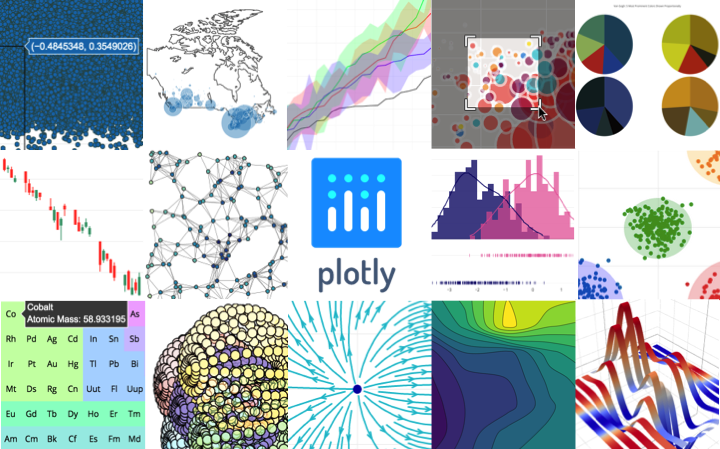Plotly.js is a standalone Javascript data visualization library, and it also powers the Python and R modules named plotly in those respective ecosystems (referred to as Plotly.py and Plotly.R).
Plotly.js can be used to produce dozens of chart types and visualizations, including statistical charts, 3D graphs, scientific charts, SVG and tile maps, financial charts and more.
Contact us for Plotly.js consulting, dashboard development, application integration, and feature additions.
- Load as a node module
- Load via script tag
- Bundles
- Alternative ways to load and build plotly.js
- Documentation
- Bugs and feature requests
- Contributing
- Notable contributors
- Copyright and license
- Community
Install a ready-to-use distributed bundle
npm i --save plotly.js-dist-minand use import or require in node.js
// ES6 module
import Plotly from 'plotly.js-dist-min'
// CommonJS
var Plotly = require('plotly.js-dist-min')You may also consider using plotly.js-dist if you prefer using an unminified package.
In the examples below
Plotlyobject is added to the window scope byscript. ThenewPlotmethod is then used to draw an interactive figure as described bydataandlayoutinto the desireddivhere namedgd. As demonstrated in the example above basic knowledge ofhtmland JSON syntax is enough to get started i.e. with/without JavaScript! To learn and build more with plotly.js please visit plotly.js documentation.
<head>
<script src="https://cdn.plot.ly/plotly-2.30.1.min.js" charset="utf-8"></script>
</head>
<body>
<div id="gd"></div>
<script>
Plotly.newPlot("gd", /* JSON object */ {
"data": [{ "y": [1, 2, 3] }],
"layout": { "width": 600, "height": 400}
})
</script>
</body>Alternatively you may consider using native ES6 import in the script tag.
<script type="module">
import "https://cdn.plot.ly/plotly-2.30.1.min.js"
Plotly.newPlot("gd", [{ y: [1, 2, 3] }])
</script>Fastly supports Plotly.js with free CDN service. Read more at https://www.fastly.com/open-source.
While non-minified source files may contain characters outside UTF-8, it is recommended that you specify the charset when loading those bundles.
<script src="https://cdn.plot.ly/plotly-2.30.1.js" charset="utf-8"></script>Please note that as of v2 the "plotly-latest" outputs (e.g. https://cdn.plot.ly/plotly-latest.min.js) will no longer be updated on the CDN, and will stay at the last v1 patch v1.58.5. Therefore, to use the CDN with plotly.js v2 and higher, you must specify an exact plotly.js version.
You could load either version two or version three of MathJax files, for example:
<script src="https://cdnjs.cloudflare.com/ajax/libs/mathjax/2.7.5/MathJax.js?config=TeX-AMS-MML_SVG.js"></script><script src="https://cdn.jsdelivr.net/npm/[email protected]/es5/tex-svg.js"></script>When using MathJax version 3, it is also possible to use
chtmloutput on the other parts of the page in addition tosvgoutput for the plotly graph. Please refer todevtools/test_dashboard/index-mathjax3chtml.htmlto see an example.
You may simply load virtual-webgl script for WebGL 1 (not WebGL 2) before loading other scripts.
<script src="https://unpkg.com/[email protected]/src/virtual-webgl.js"></script>There are two kinds of plotly.js bundles:
- Complete and partial official bundles that are distributed to
npmand theCDN, described in the dist README. - Custom bundles you can create yourself to optimize the size of bundle depending on your needs. Please visit CUSTOM_BUNDLE for more information.
If your library needs to bundle or directly load plotly.js/lib/index.js or parts of its modules similar to index-basic in some other way than via an official or a custom bundle, or in case you want to tweak the default build configurations, then please visit BUILDING.md.
Official plotly.js documentation is hosted at https://plotly.com/javascript.
These pages are generated by the Plotly graphing-library-docs repo built with Jekyll and publicly hosted on GitHub Pages. For more info about contributing to Plotly documentation, please read through contributing guidelines.
Have a bug or a feature request? Please open a Github issue keeping in mind the issue guidelines. You may also want to read about how changes get made to Plotly.js
Please read through our contributing guidelines. Included are directions for opening issues, using plotly.js in your project and notes on development.
Plotly.js is at the core of a large and dynamic ecosystem with many contributors who file issues, reproduce bugs, suggest improvements, write code in this repo (and other upstream or downstream ones) and help users in the Plotly community forum. The following people deserve special recognition for their outsized contributions to this ecosystem:
| GitHub | Status | ||
|---|---|---|---|
| Alex C. Johnson | @alexcjohnson | Active, Maintainer | |
| Mojtaba Samimi | @archmoj | @solarchvision | Active, Maintainer |
| Antoine Roy-Gobeil | @antoinerg | Active, Maintainer | |
| Emily Kellison-Linn | @emilykl | Active, Maintainer | |
| Hannah Ker | @hannahker | @hannahker11 | Active, Maintainer |
| Étienne Tétreault-Pinard | @etpinard | @etpinard | Hall of Fame |
| Nicolas Kruchten | @nicolaskruchten | @nicolaskruchten | Hall of Fame |
| Jon Mease | @jonmmease | @jonmmease | Hall of Fame |
| Mikola Lysenko | @mikolalysenko | @MikolaLysenko | Hall of Fame |
| Ricky Reusser | @rreusser | @rickyreusser | Hall of Fame |
| Dmitry Yv. | @dy | @DimaYv | Hall of Fame |
| Robert Monfera | @monfera | @monfera | Hall of Fame |
| Robert Möstl | @rmoestl | @rmoestl | Hall of Fame |
| Nicolas Riesco | @n-riesco | Hall of Fame | |
| Miklós Tusz | @mdtusz | @mdtusz | Hall of Fame |
| Chelsea Douglas | @cldougl | Hall of Fame | |
| Ben Postlethwaite | @bpostlethwaite | Hall of Fame | |
| Jack Parmer | @jackparmer | Hall of Fame | |
| Chris Parmer | @chriddyp | Hall of Fame | |
| Alex Vados | @alexander-daniel | Hall of Fame |
Code and documentation copyright 2021 Plotly, Inc.
Code released under the MIT license.
This project is maintained under the Semantic Versioning guidelines.
See the Releases section of our GitHub project for changelogs for each release version of plotly.js.
- Follow @plotlygraphs on Twitter for the latest Plotly news.
- Implementation help may be found on community.plot.com (tagged
plotly-js) or on Stack Overflow (taggedplotly). - Developers should use the keyword
plotlyon packages which modify or add to the functionality of plotly.js when distributing through npm.















